

-
8 June 2015
- From the section Technology
It’s a scenario straight out of a Hollywood movie. A disaster too dangerous for humans to enter, so a robot must drive alone into the area, and do the dirty work of inspecting, repairing and clearing the site.
That was the scenario at the Darpa Robotics Challenge last weekend at the Los Angeles County Fairgrounds.
The muscly, humanoid robots looked like Terminators, but they moved like drunks trying to pass a sobriety test. We were 35 miles from the heart of Hollywood, but a world away in terms of robot capabilities.
“It’s like watching paint dry,” remarked Brad Tousley, director of tactical technology at Darpa – the US Defense Department’s research unit – as he watched the excruciatingly slow robots attempt to perform eight simple tasks in an hour.
At times it devolved into slapstick, with robots falling flat on their humanoid faces to groans and gasps (and laughter) from the crowds.
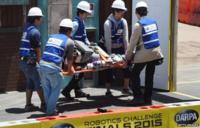
Robots unplugged
The finals involved the robots having to function untethered. And that meant a lot of accidents.
Only three out of 23 teams from around the world managed to complete all eight tasks.
The top $2m (£1.3m) prize went to South Korea’s Team Kaist, which finished significantly faster than any other team in 44 minutes 28 seconds.
Three teams did not manage to complete any of the eight tasks, which included driving a car, drilling a hole in a wall, and walking up stairs.
Two surprise tasks were pulling a lever down on day one and unplugging a power cord from one outlet and plugging it into another socket.
“Drill baby, drill! Don’t you want to get your PhD?” One spectator shouted as a robot struggled to manoeuvre the equipment.
Heckling at the Super Bowl – or World Cup – of robotics is also decidedly different from the world of football.
Typically, when a robot fell, team members would rush in to help, often carrying the robot out on a stretcher.
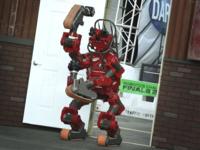
A chimp-like robot from Carnegie Mellon University dazzled the crowd during the first day of the competition by recovering from a hard fall getting out of the car.
Chimp got back up on its own without human help and kept working – truly showing the possibilities of what robots could do in a disaster.
It placed third in the competition, earning a $500,000 prize from Darpa.
Perhaps the biggest showman of the contest was second place winner, IHMC Robotics from Florida, which took home a $1m prize.
Its robot, nicknamed Running Man, was so confident on its second day finish that when it completed the final task of climbing stairs onto a podium, it thrust its humanoid arms in victory, did a little dance and then tripped and collapsed.
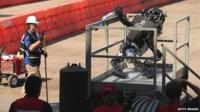
But Team Kaist was dramatically faster on day two and quietly finished with a time impossible for any of the others to beat.
Team Kaist’s leader, Jun Ho Oh, credited his success with his robot’s strong structure and ability to both walk and roll on its legs when needed.
And his robot did not fall down.
“When I saw the robots falling down, I felt a heartbreaking sensation,” Jun said, adding that the real winners were the robots who managed to get back up and keep working.
“They overcame the disaster by themselves – that is the real meaning. They got back up.”
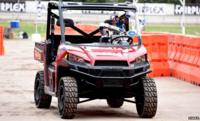
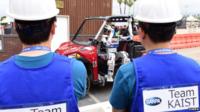
Droid drop-outs
There were meant to be 25 teams competing, but Japan’s team Hydra dropped out at the last minute because of an electronics accident during training.
A Chinese team was also due to compete but reportedly couldn’t get its visas organised in time.
Darpa’s Gill Pratt designed the challenge to become increasingly difficult over three years.
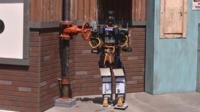

He was inspired by the Fukushima nuclear disaster of 2011, where robots were used to transmit video and data back in the aftermath but were not able to carry out repairs or prevent damage.
But the “D” in Darpa stands for “defence,” not “disaster” and that makes some observers wary, fearing autonomous disaster response robots could become autonomous killer robots in the future.
The robots in the challenge did work semi-autonomously – driving cars and clearing or walking over rubble, all with intermittent communications with their human handlers, simulating a real disaster.
Today’s slow drilling robot could be tomorrow’s soldier touting an AK-47.
“The organisers of the Darpa Robotics Challenge as well as the entrants should make crystal clear that no research project will be aimed or contribute to the development of fully autonomous weapons systems, where there is no longer meaningful human control of targeting and attack decisions,” said Mary Wareham, coordinator of the Campaign to Stop Killer Robots, a global coalition of non-governmental organisations.
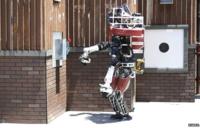
Robotic weapons
Darpa officials say the contest was not about weaponising robots, but about advancing robotics.
But they didn’t rule out the possibility that the technology could one day be used in warfare.
“Certainly robots like this could be adapted to have weapons as part of them but I could say the same thing about the healthcare robot that takes you from the bed to the shower,” Mr Pratt said.
“They are just things – and they can be used for any number of purposes. And it’s up to us in society to decide what they are going to be used for.”
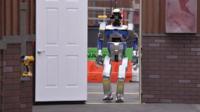
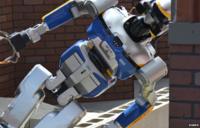
The contest was predominantly made up of US academic teams, and then aside from the winning South Koreans, there were teams from Japan, Italy, Germany and Hong Kong.
Many of the roboticists say they think there is a cultural difference in how societies treat and relate to robots and that Westerners are not as open to robots as Japanese and Korean people.
Clark Haynes, of Carnegie Mellon University’s team who built Chimp, said the school is more like Japan than the rest of the United States because it embraces a future where robots can improve our lives.
“The challenge is a collaboration between humans operating the robot and the robot itself,” he said.
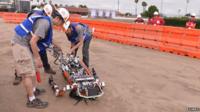
“It’s not like these are robots with self-intent. The robots are just tools, it’s just a better hammer for a unique task.”
Some say robots are “immigrants from the future”.
If that’s true, we shouldn’t fear them taking over our militaries or jobs – at least not yet anyway.
For now, they can barely walk or turn a door knob.

